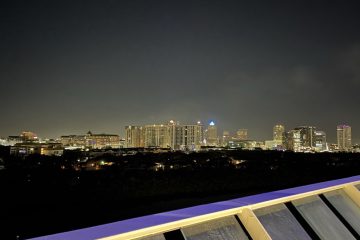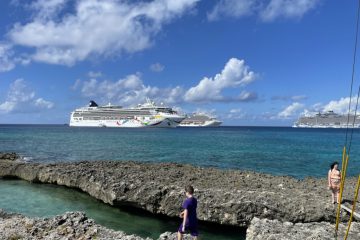Cuba, the Forbidden Island
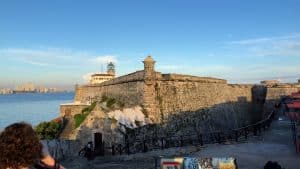 Cuba, off limits to United States Citizens since 1962, it is often called the “Forbidden Island”. A communist country located just south of the US in the Caribbean Sea, most US citizens have not seen it (and many don’t want to visit based on fear and misinformation). I hope that this will enlighten you, get your curiosity up, and inspire you to travel to Cuba.
Cuba, off limits to United States Citizens since 1962, it is often called the “Forbidden Island”. A communist country located just south of the US in the Caribbean Sea, most US citizens have not seen it (and many don’t want to visit based on fear and misinformation). I hope that this will enlighten you, get your curiosity up, and inspire you to travel to Cuba.
Cruising
We have enjoyed cruising in the past, but several years ago Teresa found that she was ill after getting of the ship. It was a physical malady, not a virus or disease. For several days after getting off the ship, she still felt like the world was rocking back and forth, shifting under her suddenly. She did a lot of research and found she had the symptoms of Mal de Débarquement Syndrome. We had not been on a cruise since.
So imagine my surprise when Teresa suggested we take a trip, a cruise to Cuba!
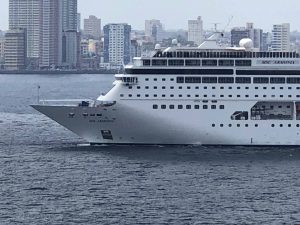 She had done a lot of research over the years about MDDS and ways to avoid symptoms. She wanted a short trip and Carnival sailed out of Tampa on three and four day cruises. She also wanted to see something new and different and the four day cruise was now sailing to Cuba.
She had done a lot of research over the years about MDDS and ways to avoid symptoms. She wanted a short trip and Carnival sailed out of Tampa on three and four day cruises. She also wanted to see something new and different and the four day cruise was now sailing to Cuba.
Cuba has been off limits to Americans for decades and the changes put in place by the previous administration made it possible now to visit Cuba. The current administration, wanting to reverse every possible decision and policy of the previous administration, is trying to make it impossible again to do business or travel to Cuba. this is, in my opinion, very short sighted. The US is one to the FEW countries with an embargo in place and the only ones it is really hurting is the US.
Teresa found the sail date with a cabin that was centrally located, spacious with an extended balcony. We looked at the requirements and found that we can get our visa directly from the cruise line for just $75 each. There are 12 reasons or requirements for US Citizens can use to travel to Cuba. The one Carnival uses “Educational activities, including People-to-People exchange programs”.
According to Carnival, we had two choices, use their excursions with their tours which give audit-ability and protection, or venture out on your own with a travel plan. It seemed like the best (and only) way to get off the ship in Cuba was to use their excursions. So we booked one in the afternoon and one for the next morning. We learned later that we had more freedom than we thought we would according to the Carnival website.
En Route
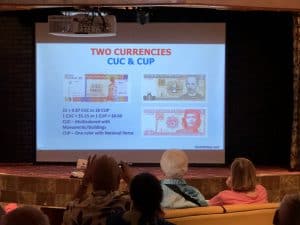 After boarding and setting sail on the Paradise, we unpacked then headed to one of the sessions on Cuba. It was led by Heidi Siefkas. She had made 50 trips to Cuba and had plenty of insight. She talked about currency exchange (and the two currencies), the people, what we could and could not take or do in Cuba and what we could. She explained the limits of what we could bring back too. She explained how we needed to fill out our visa’s and what to do if we made a mistake on them. She offered some great information.
After boarding and setting sail on the Paradise, we unpacked then headed to one of the sessions on Cuba. It was led by Heidi Siefkas. She had made 50 trips to Cuba and had plenty of insight. She talked about currency exchange (and the two currencies), the people, what we could and could not take or do in Cuba and what we could. She explained the limits of what we could bring back too. She explained how we needed to fill out our visa’s and what to do if we made a mistake on them. She offered some great information.
As I said, there are two currencies in Cuba, the CUC (CUban Convertible peso) and the CUP (CUban Peso). The CUP is the peso and is the one used by the government to pay its citizens. The CUC is the “tourist” money and is what is used to pay for tours, for food, for souvenirs, for tips and for toilet paper (.25 CUC’s , a coin like the quarter, will get you two to three squares of toilet paper). Oh, and we learned that you do not flush the paper… it is tossed in a bin as the sewer system may not be able to handle anything other than waste. Toilet seats are also a luxury, so be prepared to “hover”. This did not scare us, though. We had brought “wipes” and such. Heidi (and the Paradise crew) told the passengers it might be a good idea to take toilet paper from the ship and many did.
Arriving
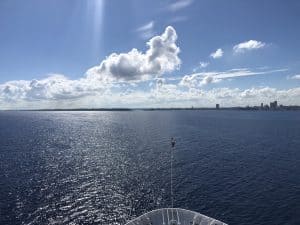 Shortly after breakfast, we went to the front deck. I wanted to watch as we came into port. We had not done a lot of research on our destination. I was surprised to see a large city, with sky scrapers on the horizon. This was not what I was expecting.
Shortly after breakfast, we went to the front deck. I wanted to watch as we came into port. We had not done a lot of research on our destination. I was surprised to see a large city, with sky scrapers on the horizon. This was not what I was expecting.
We arrived Friday late morning. We had a letter in our room that allowed us to be one of the first ones off the ship. We had an excursion booked later in the afternoon. As I stated, we had learned that we had more freedom to explore than we initially thought and had wanted to explore a bit before the excursion.
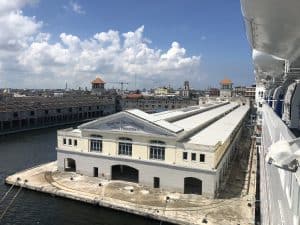 Unfortunately, it took a while to get into port. We sailed in and docked at the Terminal De San Francisco. Of the three terminal buildings, only one was in any condition for ships. The other two looked like either hurricane had ripped them apart or they had salvaged parts of those buildings to keep the one open.
Unfortunately, it took a while to get into port. We sailed in and docked at the Terminal De San Francisco. Of the three terminal buildings, only one was in any condition for ships. The other two looked like either hurricane had ripped them apart or they had salvaged parts of those buildings to keep the one open.
We did not get any time before our “antique car excursion”. We decided to go to our departure point for our excursion first and we waited. The disembarkation process was simple enough. Take your “Sail and Sign” card (to get on and off the ship), your passport (remember you need two blank pages and your passport must be valid for six months after your arrival date), and your visa (carefully filled out). Unless you are using your cell phone as a camera, leave it on the ship. Cell service is quite expensive and spotty and there is no internet. And bring the cash you are wanting to convert (at our rate of exchange, it was suggested that we exchange $150 per person per day). While that seems like a lot, remember that you will not have the use of your credit cards. Better to have cash and not need than to not have cash and be wanting.
Touring
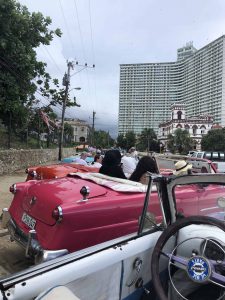 We had two tours booked, a “Classic Cars” tour in the afternoon, some free time, and a walking tour the next (early) morning. After exchanging our money, we got on a bus at the port and was taken to a staging area where there was a line of classic cars. We got our choice of several cars from Chevys to Fords, from Dodge to Pontiacs, all from the 1940’s and 50’s.
We had two tours booked, a “Classic Cars” tour in the afternoon, some free time, and a walking tour the next (early) morning. After exchanging our money, we got on a bus at the port and was taken to a staging area where there was a line of classic cars. We got our choice of several cars from Chevys to Fords, from Dodge to Pontiacs, all from the 1940’s and 50’s.
Now these cars LOOKED classic, but any collector would be shocked and appalled. Since the Revolution, Castro (not the US) banned the importation of American cars and mechanical parts. Because of that, a car owner had to do with what he had to make repairs. To this day, that means taking a part from another source, a Ford part machined to fit a Chevy or maybe under the hood of that Dodge burns the fire of a Russian made engine. Cars like these are handed down from one generation to the next, staying in the family. Privately owned vehicles have been used in Cuba for many years as a means of income.
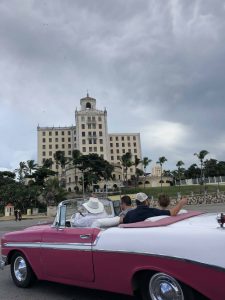 The tour was part of the “Educational activities, including People-to-People exchange program”, we learned a lot more about Cuba and its economy. Tourism is a major industry in Cuba (third behind pharmaceutical research, and energy production). Cuba is still a communist government/society. Healthcare and more in Cuba is free, including education up to doctorates. However as we learned, the pay does not go up just because you are higher educated or skilled. The average pay for a Cuban national is between $28 and $32 dollars per month (742 – 848 CUP) . Our tour guide was a commercial pilot, but found he could make more money through tips than he could as a pilot. Another tour guide said his wife quit her practice as a doctor to also become a tour guide. Even though education, healthcare, housing, food and more are given to the citizens, there are expenses such as upkeep/maintenance, utilities such as water and electricity and more that do need to be paid for.
The tour was part of the “Educational activities, including People-to-People exchange program”, we learned a lot more about Cuba and its economy. Tourism is a major industry in Cuba (third behind pharmaceutical research, and energy production). Cuba is still a communist government/society. Healthcare and more in Cuba is free, including education up to doctorates. However as we learned, the pay does not go up just because you are higher educated or skilled. The average pay for a Cuban national is between $28 and $32 dollars per month (742 – 848 CUP) . Our tour guide was a commercial pilot, but found he could make more money through tips than he could as a pilot. Another tour guide said his wife quit her practice as a doctor to also become a tour guide. Even though education, healthcare, housing, food and more are given to the citizens, there are expenses such as upkeep/maintenance, utilities such as water and electricity and more that do need to be paid for.
So let’s look at the a tour guide. These tours are state owned and run. Say the tours run 3 times a day (3-4 hours a tour) and say they get 30 people in each. The suggested tip for the tour operator is 10-15 CUC per person. So, 90 people tipping 12.5 is 1,125 per day at 20 days a month (being conservative, many work more) and you are up to 22,500 CUC per month. So just through tips, the tour guide could be supplementing his/her income by 596,250 CUP per month. For our tour, we had three guides and the bus driver. If they divided the tips evenly, that is still just over 149,000 CUP added to their salary each month. Of course, nothing was mentioned about how much the government might take from that.
There was also the “Classic Car” driver, who was independant. He is paid usually by the hour, usually about $40USD per hour. If the driver can be on the road for say 7 hours a day and 6 days per week, that is 178,080 CUP per month. Now, they need to take into account fuel costs and other maintenance, but still it is quite lucrative over the regular state job.
Our tour took us through other parts of town, Revolutionary Square, passed several neighborhoods and squares and into a dance theater where we saw an interpretive dance show whose title translated into “Memories”. I found it quite interesting, even though I spoke little Spanish. Teresa and I discussed it afterwards and it was so open to interpretation that is was almost like to we saw two different shows.
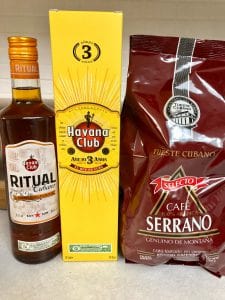 Our tour ended at a shop where we could buy cigars, rum and coffee. Being as sensitive to tobacco as Teresa is, I though better of buying the cigars (though in hindsight I could have brought some back for friends). We did buy some rum for us and coffee for my mother. We then headed back to the ship where we wanted to freshen up before seeing Havana at night.
Our tour ended at a shop where we could buy cigars, rum and coffee. Being as sensitive to tobacco as Teresa is, I though better of buying the cigars (though in hindsight I could have brought some back for friends). We did buy some rum for us and coffee for my mother. We then headed back to the ship where we wanted to freshen up before seeing Havana at night.
In our discussions throughout the day with the tours guides (which were all state sponsored) and the cruise staff, we found out that we were a bit misinformed. We thought that the only way leave the ship was through a state run tour. That is incorrect. You must meet a minimum requirement and the rest can be free time. We booked two tours, one for the afternoon and one for the next morning (4 hours on each). We learned that the the minimum is 8 hours of exchange for every 24 hours you are there, with a minimum of 4 hours. Since our ship was only ported for 23 hours, we only NEEDED to do 4 hours. Still, it was too late to “unbook” our second tour. Besides, it was a walking tour and I am sure we would see more.
Havana at Night
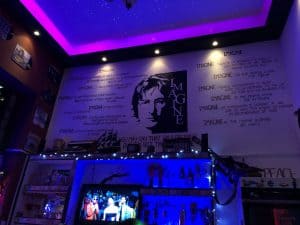
Cuban Cruise
We knew now that we were free to explore. As always with Teresa being a vegetarian, there is a dietary concern when looking for places to eat. But we also like to immerse ourselves in other cultures as best as we can and experience it. In Cuba, they cook with lard and it is heavy on the pork side, so we wanted to be careful of the local cuisine. “Dirty Rice” and root vegetables can be made without lard, if you know how to ask.
We found John Lennon’s Bar. Actually, we were led to it by a local (whom we tipped). He assured us that they would make Teresa’s dish fresh and without lard. The food was good as was the atmosphere. The place was small, only about 20 seats.
We walked around Havana after dinner. We wanted to find a market or something. Much of the areas we walked through were residential, which was okay. We never felt threatened. Many of the homes had no AC, so windows and doors were open. Peeking into the homes as we walked past, I saw very few TVs but most all of them has music playing.
As far of the cultural exchange we learned that while Cuba is still communistic, capitalism is not forbidden. As a matter of fact, it is not even discouraged as long as it does not interfere with your assigned duties. For example, say you were good at baking and had some extra room in your home/house. You could get some extra sugar or flour, maybe trading your neighbors coffee or something else for it. Then you can bake sweet treats and sell them. Any money you make is yours; you can save it or reinvest it. These shops vary in their offerings, food, drinks, sweets, even a few home-made souvenirs. We tried one of the bakeries and it was good. Be careful, though. If you pay with CUCs in an area that is not touristy, you may find that they only have CUPs and those are harder, if no impossible to exchange. After a few more hours of wandering, we retired back to the ship.
Touring AM
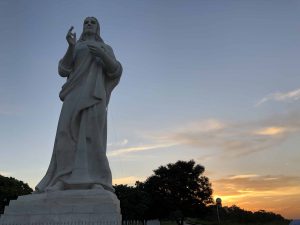 We got up very early for our next excursion. We disembarked and got down to the pier. Another cruise ship form the Oceanic cruise line was coming in. It was still dark and the ship was all lit up. The only berth was on the other side of the pier. We boarded our bus (which is strange considering this was advertised as a walking tour). Once on the bus, we were told which sites we were going to see. Our guide was trying to get us to the Old Spanish Fort and Statue De Christie for sunrise.
We got up very early for our next excursion. We disembarked and got down to the pier. Another cruise ship form the Oceanic cruise line was coming in. It was still dark and the ship was all lit up. The only berth was on the other side of the pier. We boarded our bus (which is strange considering this was advertised as a walking tour). Once on the bus, we were told which sites we were going to see. Our guide was trying to get us to the Old Spanish Fort and Statue De Christie for sunrise.
The panoramic views of Old Havana were amazing. Next to the statue was the home of one of Cuba’s recent leaders, La Cabana de Che Guevera and Monument of Civil Defense. Here our tour guide told us about how Cuba survived Hurricanes like Irma by using their civil defense system. He went on to say how they dropped their power grid in sections to protect the grid and power it back on when storm had passed, therefore not losing the grid to the storm. Having lived through Hurricane Irma, I am not sure how much of that was propaganda and what was true. Still, there was an interesting statue outside.
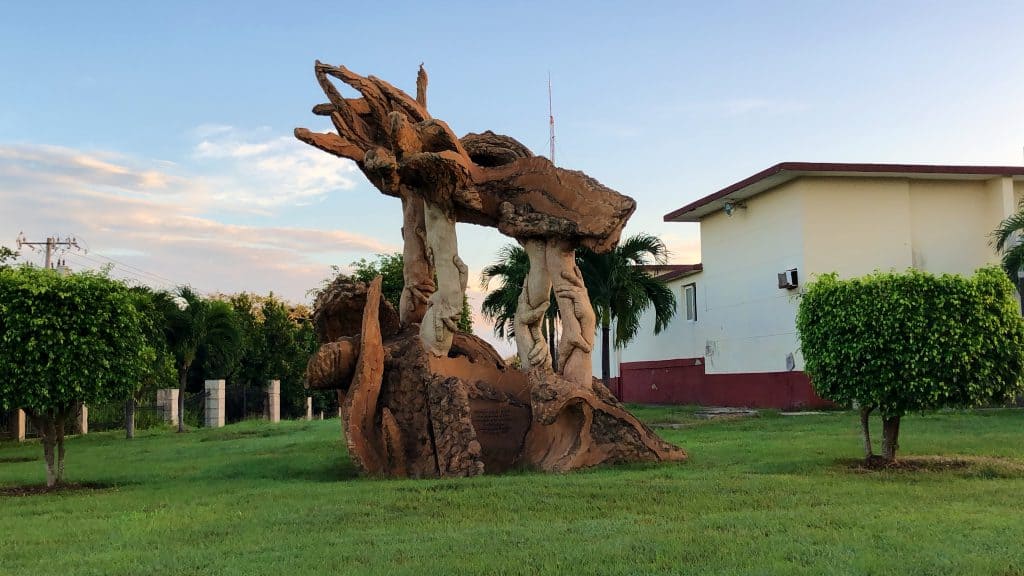
Outside the fence, there was a statue with a plague, written in Spanish of course. Using several tools when I go home (and want little Spanish I remembered from High School), this is the best translation I could muster.
MONUMENT DIGESTED TO THE CIVIL DEFENSE OF CUBA
In their composition they are represented in an abstract way, the wind, the fire, the water, even the tectonic plates and in the middle of that vortex, like trunks that do not respond to that impact, if not struggle, there is solidarity of man with the inclusion of figurative elements that are the arms.
The monument is 7 meters high, the technique employs is ferro cement worked with additives chemicals that make a waterproof material for avoid corrosion. According to his sculptor, this technique gives the possibility of working with freshness to achieve richness of texture and movement, while integrating by the nobility of the material in terms of color and Eusebio Leal.
– Spengler, director of the Office of the Historian of the Cuban sculptor Andrés González González City of Havana, (Pinar del Rio, 1957) pronounced the Marti Author of the anti-imperialist rostrum inaugural words He holds the medal medal for the Hazaña Laboral and the Machete Replica in the unveiling of Mambi’s Generalissimo alentorno Máximo Gómez, among other monuments awards and distinctions.

We also got to walk around the Old Spanish Fort. It is the oldest in the Caribbean. We probably could have explored there for hours, but we had little time.
For a walking tour, we drove a lot. We drove to the north shores where many of the famous hotels (like the Copa Cabana) were. We went to Revolutionary Square (again, and heard the same stories, again).
We then went into a museum. It was a collection (private?) of antiquities from around the world and also rooms set up portraying Cuban life. It has one rule, NO photos. There were a couple of items I would have liked to have gotten a photo of and I asked (never hurts to ask). I was turned down, though. I even offered money (like buying a photo pass). Nope, no go.
We then went to a small church, a unitarian type of church as it welcomed all faiths. In there, there had set up a small theater, rows of chairs facing an opening/stage. We were introduced to an outreach group that helps those in the neighborhood through their acts. They were seniors and “rappers”. They sang and performed for us (in Spanish, of course). They even persuaded Teresa to get up and dance with them.
The rest of the tour took us into places we had seen the day before. And, since we new we did not need to stay on the tour, when we got to a good spot, we signed out from the tour and struck out on our own.
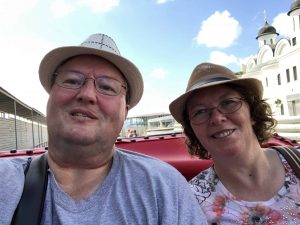 We wanted to find some squares and check out the San Jose Market. We found some neat boxes and authentic authentic Cuban straw hats. The paintings and some of the wood carvings were nice too. We had to be back at the ship before 11:30am and we were going to be cutting it close. We could take a “taxi” or “classic car”, but we also figured the horse drawn buggies were fast enough to get us back, and they were. Soon we back aboard ship ad sailing out of the harbor.
We wanted to find some squares and check out the San Jose Market. We found some neat boxes and authentic authentic Cuban straw hats. The paintings and some of the wood carvings were nice too. We had to be back at the ship before 11:30am and we were going to be cutting it close. We could take a “taxi” or “classic car”, but we also figured the horse drawn buggies were fast enough to get us back, and they were. Soon we back aboard ship ad sailing out of the harbor.
Departure
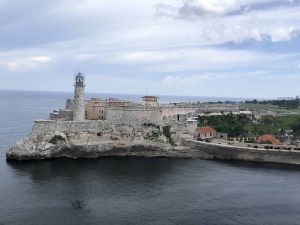 Our day started early and by noon we were on our way. We passed the old Spanish fort coming out of the harbor and met another ship coming in. Did I mention that tourism is big business in Cuba still? While the US ports have limited sailings, the European ships come and go with less restrictions. This ship was the MSC Armonia, sailing out of Miami. It was going to take the berth we just vacated.
Our day started early and by noon we were on our way. We passed the old Spanish fort coming out of the harbor and met another ship coming in. Did I mention that tourism is big business in Cuba still? While the US ports have limited sailings, the European ships come and go with less restrictions. This ship was the MSC Armonia, sailing out of Miami. It was going to take the berth we just vacated.
The rest of the day and evening was spent wandering the ship, playing bingo, enjoying music and relaxing on our balcony before heading to the dining room for dinner.
Fun Day at Sea
We woke up to smooth sailing. While I hardly felt the boat moving, Teresa said she could feel it. We went up for breakfast and planning out day. There is something to do for almost everyone, shows, games, sunbathing, drinking, comedy, eating, gambling and more. So whatever you are into, you can most likely find it.
We went to a few of the shows and games. We all went to the Library of the ship. There are more than books there and it is relatively quiet (it is a library). In this case, we were hoping to find some games. We did not pack any of our own this time and we wish we had. They had little in the library and what they did have was “old school” or boring. I grabbed a couple of backgammon games and pulled the dice out (no one else was in there playing). I also grabbed a scrap of paper and pencil and draw up a Yahtzee score card. It was nothing elaborate, but it was better than nothing.
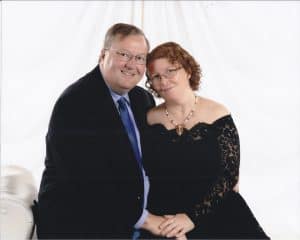 We left and got dressed up. It was the formal night of the cruise and the cruise had several backdrops for photos. Eat photographer was a bit different in how he or she posed you, either as a couple or as an individual. The nice thing these days is that your photos are digital and sent (watermarked) right to your smartphone app to order.
We left and got dressed up. It was the formal night of the cruise and the cruise had several backdrops for photos. Eat photographer was a bit different in how he or she posed you, either as a couple or as an individual. The nice thing these days is that your photos are digital and sent (watermarked) right to your smartphone app to order.
The show that night was a Rock and Roll tribute to the 80’s. The performers did a pretty good job, adding their own touch or flavor to the songs. There was also a late night comedy show going on, but we decided to call it a night.
Arriving Home
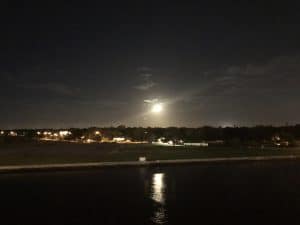 We arrived back in the port of Tampa before the sun rose. It was cool coming into town before the town was awake. We had our stuff packed and read to go. Since we were not using luggage services and we were in a suite, we had instructions on where to go and what to do for immigration and customs.
We arrived back in the port of Tampa before the sun rose. It was cool coming into town before the town was awake. We had our stuff packed and read to go. Since we were not using luggage services and we were in a suite, we had instructions on where to go and what to do for immigration and customs.
Both leaving Tampa and coming back into Tampa was easy. We’ve been to places where it is go to this line, wait, that line and wait, back over …. Tampa was not like that. I would highly recommend traveling out of Tampa. They may not be the super ships, but they are worth it.
Oh, and as for Teresa’s MDDS? Did the short trip and calm seas help? Nope. And this is unfortunate as we will probably never cruise again until a cure is found.
—

